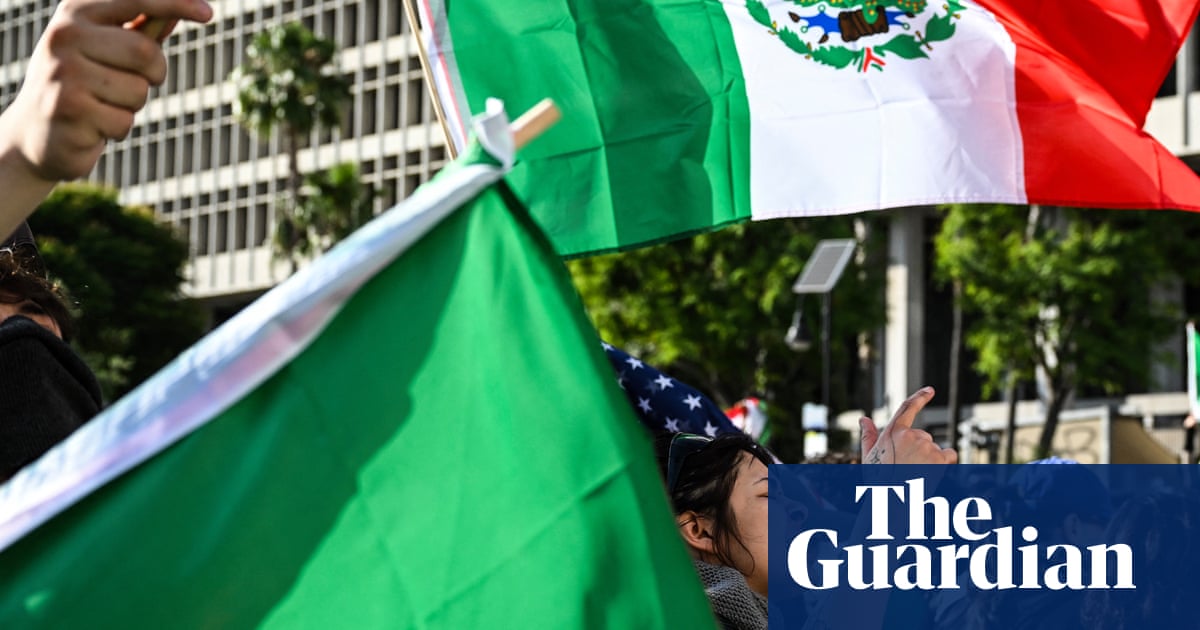At the White House on Wednesday, the press secretary, Karoline Leavitt,told reportersDonald Trump’s decision to dispatch the military to Los Angeles had been triggered by something he’d seen: “images of foreign flags being waved” during protests over federal immigration raids.
Leavitt did not specify which images the president had been so disturbed by, but the fact that some protesters denouncing his immigration crackdown have waved Mexican, Guatemalan and Salvadorian flags, orhybrid flagsthat combine those banners with the American flag, has been taken as an affront by supporters of his mass deportation campaign.
The architect of that policy, Stephen Miller, has complained bitterly about flag-waving protesters on the streets of his Los Angeles hometown, andsharedvideo of demonstrators on social media with the comment: “Look at all the foreign flags. Los Angeles is occupied territory.”
Trump himself even claimed, during his deeply partisan speech to soldiers at Fort Bragg on Tuesday, that his deployment of active-duty marines to the city was justified because of the protesters he called “rioters bearing foreign flags with the aim of continuing a foreign invasion”.
But observers with a more nuanced understanding of theLos Angelescommunities being targeted in these raids, and of the nation’s history as a refuge for immigrants, suggest that the flags are not intended to signal allegiance to any foreign government but rather to signal solidarity with immigrants from those places and, for Americans with roots in those countries, to express pride in their heritage.
Lalo Alcaraz, a Mexican American satirist and editorial cartoonist, who coined the term “self-deportation” in the 1990sas part of an elaborate prankin response to the anti-immigrant policies of then California governor Pete Wilson, said that the protesters carrying those flags in LA are not immigrants themselves, but “the younger generation that are American citizens and that have pride in their immigrant parents”. Their parents, he said, “are hard-working good people who come from other countries – Mexico, Guatemala, El Salvador. This is why they proudly wave those flags.”
“Of course they’re proud of their roots, and honestly, what has the American flag done for them but persecute their families?” Alcaraz added. “They are promised that there is a right way to immigrate, that there will be a pathway to citizenship, but this promise has been ignored because corporations make profits off the low wages and hard work of these immigrants, and want to keep them in limbo because it’s easier to control them.”
That sentiment was echoed by a protester named Jesus, whotold NPRduring a protest this week that he waved the Mexican flag because “I’m proud of my Mexican heritage, you know? Even though it was several generations ago, my family members were immigrants.”
As NPR’s Adrian Florido pointed out, the large number of flags from other parts of the Americas at these protests contrasted sharply with what was seen in the same place two decades ago.
In 2006, when huge marches brought hundreds of thousands of people to the streets of LA to protest against Republicans in Congress introducing a restrictive immigration bill that would close off paths to citizenship and build fences along the border, organizers urged the demonstrators to wave American flags.
“Apparently taking stock of complaints about the number of Mexican flags in previous demonstrations, organizers made sure that the vast majority of marchers Monday carried American flags,” the Los Angeles Timesreported in 2006on the massive May Day march that year. Images from that rally showed that Mexican flags were vastly outnumbered in a sea of American flags.
Others have pointed out that, for Americans with European roots, waving the flags of their ancestors, from Ireland or Italy, for example, is considered uncontroversial.
“The reason Mexicans and Mexican Americans wave the Mexican flag is the same reason the Irish wave the Irish flag,” David Bier, director of immigration studies at the Cato Institute,wroteon Friday. “Not because they want to go back there, but because they are proud of their Heritage and want to stand up for people with their ancestry.”
“When you persecute a minority, it makes them more aware of their identity and differences from the majority, slowing assimilation,” he added. “In other words, the Trump agenda is bad for the very thing Trumpists claim to want.”
In that light, it is worth recalling that charges of dual loyalty were once hurled at Irish and Italian immigrants, too. Less than a century ago, in fact, American citizens from Irish and Italian families were viewed with hatred and suspicion by native-born, white Protestants.
To take one example, when 1,000 robed members of the Ku Klux Klanriotedat the 1927 Memorial Day parade in Queens, and seven men were arrested, one of their chief targets was New York’s Irish American-led police force, which tried to prevent them from marching. One of those menwas the current president’s father, Fred Trump. (A report from the time in a Brooklyn newspaper said that “a charge of refusing to disperse from a parade when ordered to do so” against Trump was quickly dismissed.)
The deep vein of hatred Italian immigrants faced was even a motivating factor in the the first Columbus Day proclamation,issued byBenjamin Harrison in 1892. The then US president hoped to gain support from new Italian American voters, but he was also trying to absolve the country of the stain from a deadly anti-Italian riot the year before in New Orleans, in which 11 Italian immigrants had been falsely accused of murder and were lynched by a mob.
One of Trump’s first acts on returning to office this year was to issue a proclamation that Columbus Day would be celebrated during his administration without any acknowledgement of the Indigenous people who suffered so much in the centuries after his voyage to this hemisphere.
